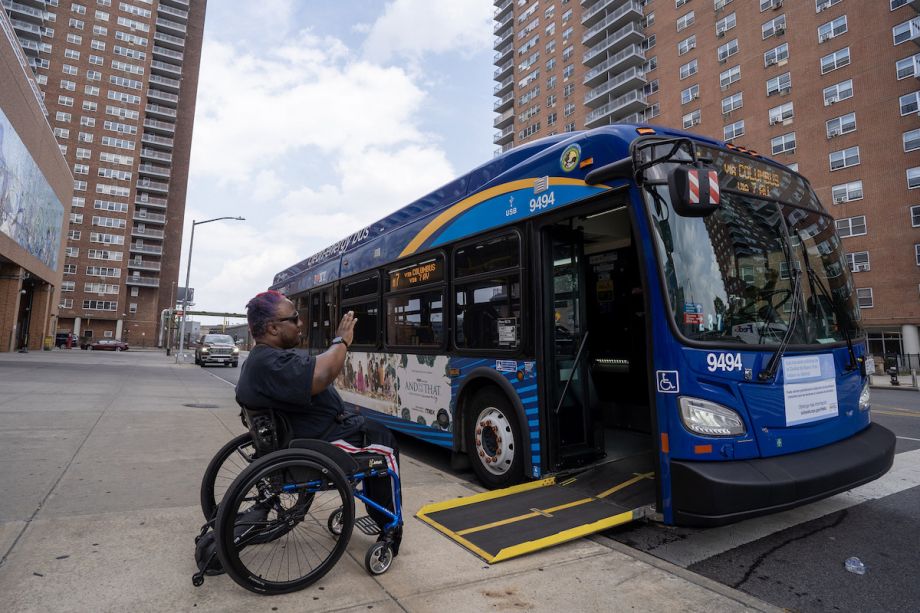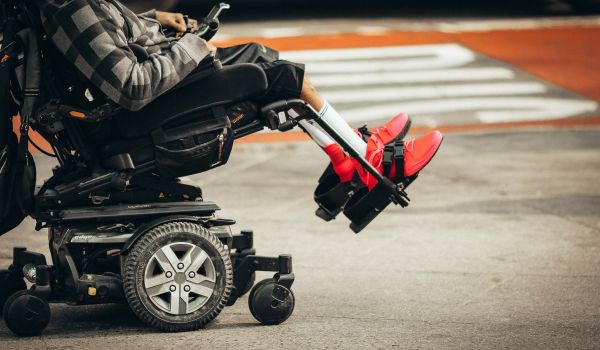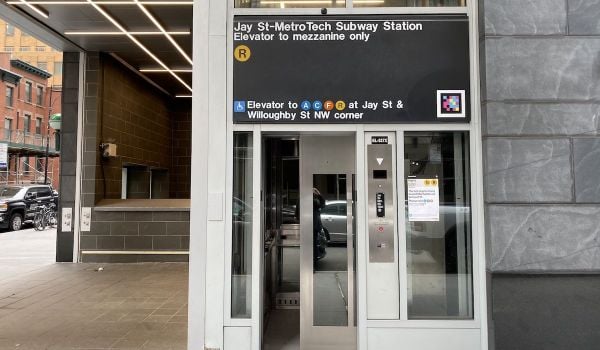The Americans with Disabilities Act (ADA) turned 33 on July 26. For a third of a century, this landmark civil rights legislation has made it possible for people with disabilities to access public spaces and participate in their communities, in ways they couldn’t in the past. This has had a marked effect on our built environment and the way cities operate—in ways that benefit both people with disabilities and the general public, as a whole.
For instance, curb ramps where sidewalks connect to crosswalks are a major benefit of the ADA. Curb ramps are not just for wheelchair users, as they make mobility safer for elderly people and families pushing strollers. Curb ramps are good for the economy, as well, because they make for easy wheeled delivery of the millions of products delivered via e-commerce daily.
Likewise, buses that have ramps, lifts, or boarding platforms for ease of access are not just for those who use assistive mobility devices, but they also make boarding easier for small children, senior citizens, and urban dwellers schlepping home groceries and goods because they live car free.
Sadly, the landmark civil rights legislation that makes these things possible—and is a game changer for more than 80 million people with disabilities in the U.S. and their families—could be watered down or all but dismantled. Several bills have been introduced in Congress and state legislatures that require any individuals who file lawsuits for public accommodations’ failure to remove architectural barriers (under Title III of the Americans with Disabilities Act) to provide the owner of such establishments with a written notice of the plaintiff’s intent to sue—to allow the would-be defendants to remedy the problem without penalty. Most contemplate allowing six or more months to remedy issues that have been in violation for decades.
You see, establishments have had 33 years’ notice to comply with ADA, because that’s how long the legislation has been in place. Congress and state legislatures do not give employers six or 12 months (or 33 years, for that matter) to learn to stop abusing someone’s civil rights based on race, gender, or religion — so why exempt the ADA, the only civil rights legislation based on disability?
READ MORE: Accessibility Lawsuits Are Bringing Slow But Steady Wins For Disabled City Residents
As a writer, planner, educator, and activist who has worked within the disability community for four decades, allow me to bust three myths that are commonly used as excuses for not complying with ADA.
Myth #1: The ADA hurts small businesses.
People repeat, without even thinking, that $25,000 to widen a door, install a ramp, or create an accessible family restroom is going to kill that mom-and-pop diner operated by the same family for 50 years.
Over a half-century, that family that owns their building would have had to replace the roof, HVAC, kitchen equipment, seating, and likely windows and other elements. It went from a cash register and scratch pad to the expense of generations of computers, plus a website and social media. If it didn’t spend big to replace or upgrade plumbing and fixtures, then it’s the filthiest, nastiest restaurant in town.
These costs easily total $250,000.
A tiny fraction of that, $25,000, to improve accessibility could bring in hundreds, or even thousands, of new customers who can now access the diner. Remember, one in four people has some kind of disability. An accessible business allows the business owner to retain veteran, valuable employees who otherwise may have to retire well before their prime if they become disabled. When factored into the many costs of doing business, accommodating people with disabilities is not an onerous expense. And with a rapidly aging America and more people with disabilities joining the workforce, it is both the right and, likely, profitable thing to do.
Myth #2: Cities can’t afford to make their facilities and public spaces more accessible.
There are a few different points to cover with debunking this one. For one thing, people with disabilities are the most under and unemployed of any marginalized group. This is because of the built environment, not their underlying disability. Spending on mobility, transit, and infrastructure that’s accessible to all would hugely improve access to education, employment, and housing for people with disabilities. That, in turn, will go back into improving the broader economy and creating a stronger tax base for cities.
Secondly, cities benefit when they invest in Universal Design—in other words, when they design places to allow ease of access and use for all, not just people with disabilities. Universal Design makes neighborhoods safer for older adults, children, families, and everyone else.
Universal Design involves measures like simply making sidewalks wider so people can move about, even in a wheelchair about three feet wide, while there still is room for benches, trash receptacles, bike racks, and, in commercial strips, outdoor seating.
Universal Design is making sure crosswalks are safe—sometimes made safer with bump-outs that extend the curb, or with a safe haven median wide enough for people to rest comfortably at if they only make it halfway across four or more busy lanes of traffic in the allotted 30 seconds.
Sometimes the goal is accomplished simply through policy: towing away cars that block the sidewalk, banning right turns on red in high pedestrian areas, or regulating dockless scooters so they are not discarded in curb ramps, crosswalks, or in the middle of sidewalks.
While these urban designs and policies are essential to the mobility of people with physical, visual, hearing, and cognitive disabilities, they are welcomed by all. A main street where people from ages 8 to 88 feel safe, comfortable, and able to enjoy urban life with calmed traffic is a main street that can compete with malls and big box store complexes.
Universal Design and accessibility also support the hugely embraced planning principle of “aging in place,” which becomes increasingly important as more than 10,000 people per day turn 65 in our nation. The idea is that if a person’s dwelling and neighborhood are largely accessible as their mobility is reduced, they can still live in the neighborhood they have been rooted in for decades. No need to move to a senior citizen community or building to live safely and comfortably—make it so that they can still play an active role in their community and economy.
(By the way, all of these measures would also fuel the local economy by employing thousands to design, build, and maintain our more humane built environment!)
I once interviewed a climate change expert who said a city may say it cannot afford $1 billion in sea level rise/flood control infrastructure…but it also cannot afford to do nothing, then suffer $10 billion in property and job losses. The same applies to accessibility. Cities cannot afford to resist spending $25 million on access for all when a barrier-free city could reap tenfold on investment in terms of independence, improved pay, enhanced quality of life, and a reduced need for government benefits by people with disabilities.
Myth #3: People with disabilities are outliers, a fringe special interest.
As noted above, the CDC has documented that one in four adults has some kind of disability. The UN has proven there are more than one billion people with disabilities on Earth.
That means a place like Miami-Dade County, for instance, has nearly 700,000 people with disabilities. I live in Little Havana, which has a population bordering 100,000. Factoring in census undercount and undocumented people, it easily has 25,000 residents with disabilities—plus all those who visit the neighborhood to work, shop, and play.
While the need is huge, Miami—like most cities in America—budgets almost no money in its capital or operating budget specifically earmarked for barrier removal and improving mobility for people with disabilities.
A landmark study published in the second quarter of 2023 by a group of Ohio State University researchers in the Journal of Transport Geography found that only 1% of Columbus, Ohio, is readily accessible to manual wheelchairs who use public transit. The number only rose to 25% for power wheelchair users.
The problem wasn’t buses, it was the sidewalks and built environment beyond the bus stop. Missing sidewalks, broken sidewalks, dangerous crosswalks, flooded curb ramps, and inaccessible buildings and facilities were why 75–99% of the city was off-limits to people with disabilities.
Researchers emphasized that these segregating, isolating numbers are not unique to Columbus, but typical of all cities that neglect pedestrian connectivity and wheelchair mobility.
If cities support mom-and-pop grants to help businesses in old buildings to become accessible, they add a potential 25% increase in customers for local businesses.
Big firms spend millions developing a new product in hopes of capturing a boost of market share by a few percent. Imagine the benefits of a coffee shop, hardware store, or hair salon that can get foot traffic from 100% of the community.
Used competently, ADA compliance and design for inclusion are an economic engine. Instead of trying to dismantle or ignore it, let’s recognize it for the potential it has to make our cities and towns better, more financially resilient, and equitable places for the people living in them.
This op-ed was originally published by Strong Towns.
Steve Wright is a writer, planner, educator, and keynote speaker who has lectured on the ADA and public policy at the American Planning Association National Conference and at the International Making Cities Livable conference in Paris. He created a groundbreaking universal design course for architects and planners and blogs daily on the inclusive city at Urban Travel, Sustainability & Accessibility.
















